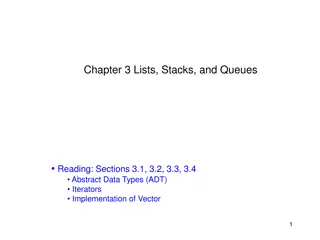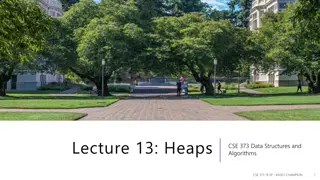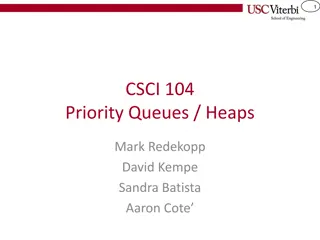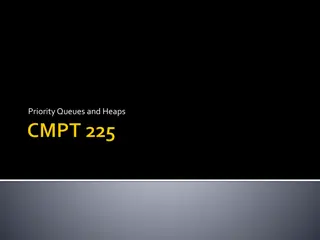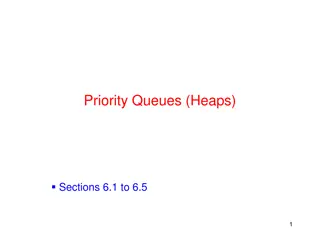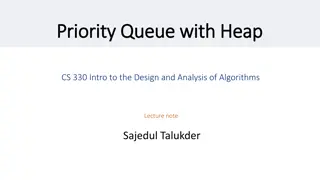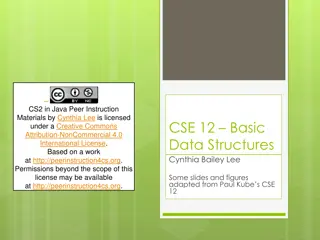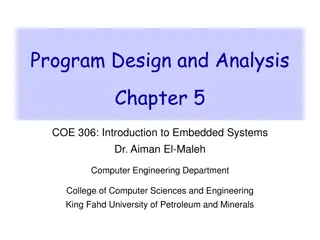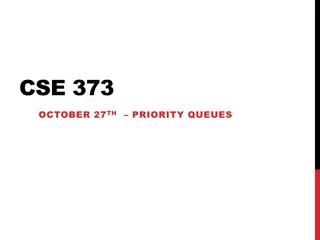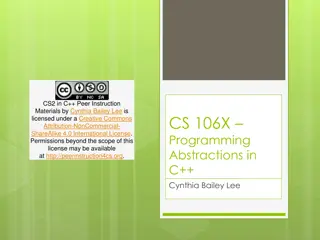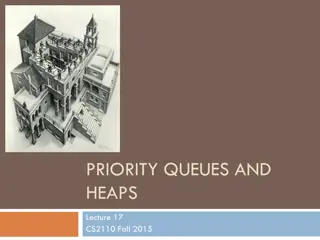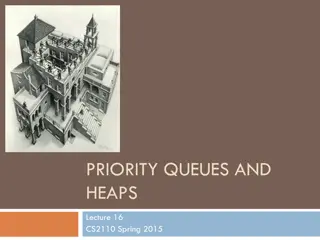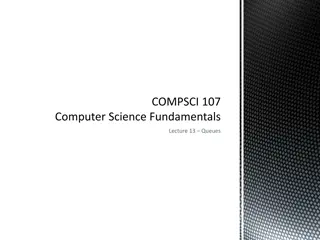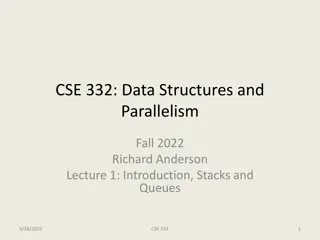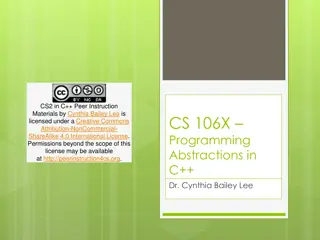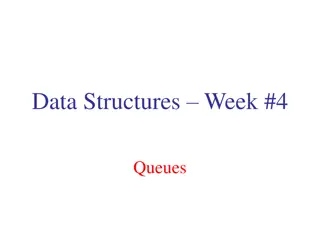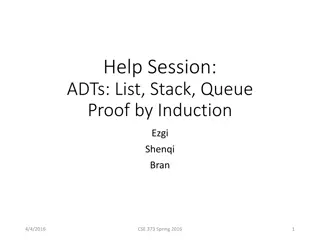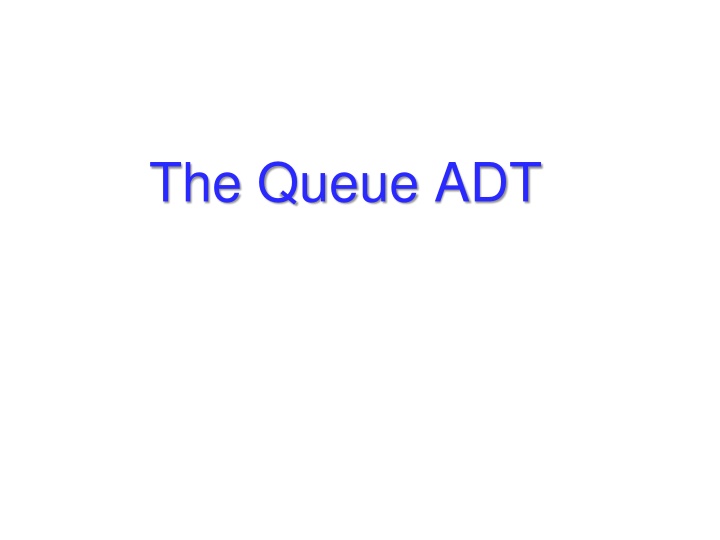
The Queue Abstract Data Type (ADT) and Its Implementations
Explore the concept of the Queue ADT, its uses in problem-solving, various implementations, and operations. Learn how queues work, see practical examples, and understand their applications in computing.
Download Presentation

Please find below an Image/Link to download the presentation.
The content on the website is provided AS IS for your information and personal use only. It may not be sold, licensed, or shared on other websites without obtaining consent from the author. If you encounter any issues during the download, it is possible that the publisher has removed the file from their server.
You are allowed to download the files provided on this website for personal or commercial use, subject to the condition that they are used lawfully. All files are the property of their respective owners.
The content on the website is provided AS IS for your information and personal use only. It may not be sold, licensed, or shared on other websites without obtaining consent from the author.
E N D
Presentation Transcript
Objectives Define the queue ADT Show how a queue can be used to solve problems Examine various queue implementations Compare queue implementations 6-2
Queues Queue: a linear collection whose elements are added at one end (the rear or tail of the queue) and removed from the other end (the front or head of the queue) A queue is a FIFO (first in, first out) data structure Any waiting line is a queue: The check-out line at a grocery store The cars at a stop light An assembly line 6-3
Conceptual View of a Queue Adding an element Front of queue New element is added to the rear of the queue 6-4
Conceptual View of a Queue Removing an element New front element of queue Element is removed from the front of the queue 6-5
Operations on a Queue Operation Description Removes an element from the front of the queue dequeue Adds an element to the rear of the queue enqueue Examines the element at the front of the queue without removing it Determines whether the queue is empty first isEmpty Determines the number of elements in the queue size Returns a string representation of the queue toString 6-6
Interface to a Queue in Java public interface QueueADT<T> { // Adds one element to the rear of the queue public void enqueue (T element); // Removes and returns the element at the front of the queue public T dequeue( ) throws EmptyCollectionE; // Returns without removing the element at the front of the queue public T first( ) throws EmptyCollectionE; // Returns true if the queue contains no elements public boolean isEmpty( ); // Returns the number of elements in the queue public int size( ); // Returns a string representation of the queue public String toString( ); } 6-7
Uses of Queues in Computing Printer queue Keyboard input buffer GUI event queue (click on buttons, menu items) 6-8
Using Queues: Coded Messages A Caesar cipher is a substitution code that encodes a message by shifting each letter in a message by a constant amount k If k is 5, a becomes f, b becomes g, etc. Example: n qtaj ofaf Used by Julius Caesar to encode military messages for his generals (around 50 BC) This code is fairly easy to break. 6-9
Using Queues: Coded Messages Modern version: ROT13 Each letter is shifted by 13 used in online forums as a means of hiding spoilers, punchlines, puzzle solutions, and offensive materials from the casual glance (Wikipedia) 6-10
Using Queues: Coded Messages An improvement: change how much a letter is shifted depending on where the letter is in the message A repeating key is a sequence of integers that determine how much each character is shifted Example: consider the repeating key 3 1 7 4 2 5 The first character in the message is shifted by 3, the next by 1, the next by 7, and so on When the key is exhausted, start over at the beginning of the key 6-11
Using Queues: Coded Messages A repeating key is a sequence of integers that determine by how much each character in a message is shifted. Consider the repeating key 3 1 7 4 2 5 a b c d e f g h i j k l m n o p q r s t u v w x y z message: knowledge encoded message: 3 1 7 4 2 5 queue: 6-12
Using Queues: Coded Messages A repeating key is a sequence of integers that determine by how much each character in a message is shifted. Consider the repeating key 3 1 7 4 2 5 a b c d e f g h i j k l m n o p q r s t u v w x y z message: knowledge encoded message: n dequeued: 3 1 7 4 2 5 queue: 6-13
Using Queues: Coded Messages A repeating key is a sequence of integers that determine by how much each character in a message is shifted. Consider the repeating key 3 1 7 4 2 5 a b c d e f g h i j k l m n o p q r s t u v w x y z message: knowledge encoded message: n 1 7 4 2 5 3 queue: 6-14
Using Queues: Coded Messages A repeating key is a sequence of integers that determine by how much each character in a message is shifted. Consider the repeating key 3 1 7 4 2 5 a b c d e f g h i j k l m n o p q r s t u v w x y z message: knowledge encoded message: no dequeued: 1 7 4 2 5 3 queue: 6-15
Using Queues: Coded Messages A repeating key is a sequence of integers that determine by how much each character in a message is shifted. Consider the repeating key 3 1 7 4 2 5 a b c d e f g h i j k l m n o p q r s t u v w x y z message: knowledge encoded message: no 7 4 2 5 3 1 queue: 6-16
Using Queues: Coded Messages A repeating key is a sequence of integers that determine by how much each character in a message is shifted. Consider the repeating key 3 1 7 4 2 5 a b c d e f g h i j k l m n o p q r s t u v w x y z message: knowledge encoded message: novangjhl 4 2 5 3 1 7 queue: 6-17
Using Queues: Coded Messages We can use a queue to store the values of the key dequeue a key value when needed After using it, enqueue it back onto the end of the queue So, the queue represents the constantly cycling values in the key 6-18
Using Queues: Coded Messages See Codes.java in the sample code page of the course s website Note that there are two copies of the key, stored in two separate queues The encoder has one copy The decoder has a separate copy Why? 6-19
Using Queues: Ticket Counter Simulation Simulate the waiting line at a movie theatre: Determine how many cashiers are needed to keep the customer wait time under 7 minutes Assume: Customers arrive on average every 15 seconds Processing a request takes two minutes once a customer reaches a cashier See Customer.java, TicketCounter.java in the sample code page of the course s website 6-20
Results of Ticket Counter Simulation Number of Cashiers 1 2 3 4 5 6 7 8 9 10 5317 2325 1332 840 547 355 219 120 120 120 Average time (in seconds) 6-21
Queue Implementation Issues What do we need to implement a queue? A data structure (container) to hold the data elements A variable to indicate the front of the queue A variable to indicate the rear of the queue 6-22
Queue Implementation Using a Linked List A queue can be represented as a linked list of nodes, with each node containing a data item We need two pointers for the linked list A pointer to the beginning of the linked list (front of queue) A pointer to the end of the linked list (rear of queue) We will also have a count of the number of items in the queue 6-23
Linked Implementation of a Queue A queue q containing four elements rear q front 4 count 6-24
Discussion What are the values of front and rear if the queue is empty? What are their values if there is only 1 element? 6-25
Queue After Adding Element New element is added in a node at the end of the list, rear points to the new node, and count is incremented rear q front 5 count 6-26
Queue After a dequeue Operation Node containing is removed from the front of the list (see previous slide), front now points to the node that was formerly second, and count has been decremented. rear q front 4 count 6-27
Java Implementation The queue is represented as a linked list of nodes: We will again use the LinearNode class front is a reference to the head of the queue (beginning of the linked list) rear is a reference to the tail of the queue (end of the linked list) The integer count is the number of nodes in the queue 6-28
public class LinkedQueue<T> implements QueueADT<T> { /** * Attributes */ private int count; private LinearNode<T> front, rear; /** * Creates an empty queue. */ public LinkedQueue() { count = 0; front = rear = null; } 6-29
//-----------------------------------------------------------------//----------------------------------------------------------------- // Adds the specified element to the rear of the queue. //----------------------------------------------------------------- public void enqueue (T element) { LinearNode<T> node = new LinearNode<T> (element); if (isEmpty( )) front = node; else rear.setNext (node); rear = node; count++; } 6-30
//-----------------------------------------------------------------//----------------------------------------------------------------- // Removes the element at the front of the queue and returns a // reference to it. Throws an EmptyCollectionException if the // queue is empty. //----------------------------------------------------------------- public T dequeue ( ) throws EmptyCollectionException { if (isEmpty( )) throw new EmptyCollectionException ("queue"); T result = front.getElement( ); front = front.getNext( ); count--; if (isEmpty( )) rear = null; return result; } 6-31
Array Implementation of a Queue First Approach: Use an array in which index 0 represents one end of the queue (the front) Integer value count represents the number of elements in the array (so the element at the rear of the queue is in position count - 1) Discussion: What is the challenge with this approach? 6-32
An Array Implementation of a Queue A queue aq containing four elements front 0 1 2 3 4 queue aq 4 count 6-33
Queue After Adding an Element The element is added at the array location given by the value of count and then count is increased by 1. 0 1 2 3 4 queue aq 5 count 6-34
Queue After Removing an Element Element is removed from array location 0, remaining elements are shifted forward one position in the array, and then count is decremented. 0 1 2 3 4 queue aq 4 count 6-35
public class ArrayQueue<T> implements QueueADT<T> { private final int DEFAULT_CAPACITY = 100; private int count; private T[] queue; public ArrayQueue() { count = 0; queue = (T[])(new Object[DEFAULT_CAPACITY]); } public ArrayQueue (int initialCapacity) { count = 0; queue = (T[])(new Object[initialCapacity]); } 6-36
//-----------------------------------------------------------------//----------------------------------------------------------------- // Adds the specified element to the rear of the queue, // expanding the capacity of the queue array if // necessary. //----------------------------------------------------------------- public void enqueue (T element) { if (size() == queue.length) expandCapacity( ); queue[count] = element; count++; } 6-37
//-----------------------------------------------------------------//----------------------------------------------------------------- // Removes the element at the front of the queue and returns // a reference to it. Throws anEmptyCollectionException if the // queue is empty. //----------------------------------------------------------------- public T dequeue ( ) throws EmptyCollectionException { if (isEmpty( )) throw new EmptyCollectionException ( Empty queue"); T result = queue[0]; count--; // shift the elements for (int i = 0; i < count; i++) queue[i] = queue[i+1]; queue[count] = null; return result; } 6-38
Second Approach: Queue as a Circular Array If we do not fix one end of the queue at index 0, we will not have to shift elements Circular arrayisan array that conceptually loops around on itself The last index is thought to precede index 0 In an array whose last index is n, the location before index 0 is index n; the location after index n is index 0 We need to keep track of where the frontas well as therear of the queue are at any given time 6-39
Circular Array Implementation of a Queue 3 2 3 4 1 front queue 5 0 cq 8 5 6 n-1 n-2 rear count 7 n-3 .. . 8 9 10 6-40
A Queue Straddling the End of a Circular Array 98 2 3 4 1 queue front 5 0 cq 2 4 6 99 98 rear count 7 97 .. . 8 9 10 6-41
Circular Queue Drawn Linearly Queue from previous slide 98 front queue cq 0 1 2 3 4 96 97 98 99 4 2 count rear 6-42
Circular Array Implementation When an element is enqueued, the value of rear is incremented But it must take into account the need to loop back to index 0: rear = (rear+1) % queue.length; Can this array implementation also reach capacity? 6-43
Example: array of length 4 What happens? 0 1 2 3 2 queue front cq Suppose we try to add one more item to a queue implemented by an array of length 4 3 1 count rear 0 1 2 3 The queue is now full. How can you tell? 2 front queue cq 4 2 count rear 6-44
Add another item! Need to expand capacity 0 1 2 3 We can t just double the size of the array and copy values to the same positions as before: circular properties of the queue will be lost 2 queue front cq 4 2 count rear 0 1 2 3 4 5 6 7 2 front queue cq 4 2 These locations should be in use count rear 6-45
We could build the new array, and copy the queue elements into contiguous locations beginning at location front: 0 1 2 3 4 5 6 7 2 front queue cq 6 4 rear count 6-46
Or, we could copy the queue elements in order to the beginning of the new array 0 1 2 3 4 5 6 7 0 front queue cq 4 4 rear count 6-47
New element is added at rear = (rear+1) % queue.length See expandCapacity() in CircularArrayQueue.java 0 1 2 3 4 5 6 7 0 front queue cq 5 5 rear count 6-48
Pseudocode for the Enqueue Operation Using a Circular Array Implementation of a Queue Algorithm enqueue(element) if queue is full then expandQueue() rear = (rear + 1) mod size of queue queue[rear] = element ++count Algorithm expandQueue() q = new array of size 2 * size of queue copied = 0 // number of elements copied to the larger array i = 0 // index of next entry in array q j = front // index of next entry in array queue while copied < count do { // copy data to new array q[i] = queue[j] ++i j = (j + 1) mod size of queue ++ copied } rear = count 1 // position of last element in the queue front = 0 queue = q 6-49
Enqueue Operation in Java public void enqueue (T element) { if (count == queue.length) expandQueue(); rear = (rear + 1) % queue.length; queue[rear] = element; ++count; } 6-50

